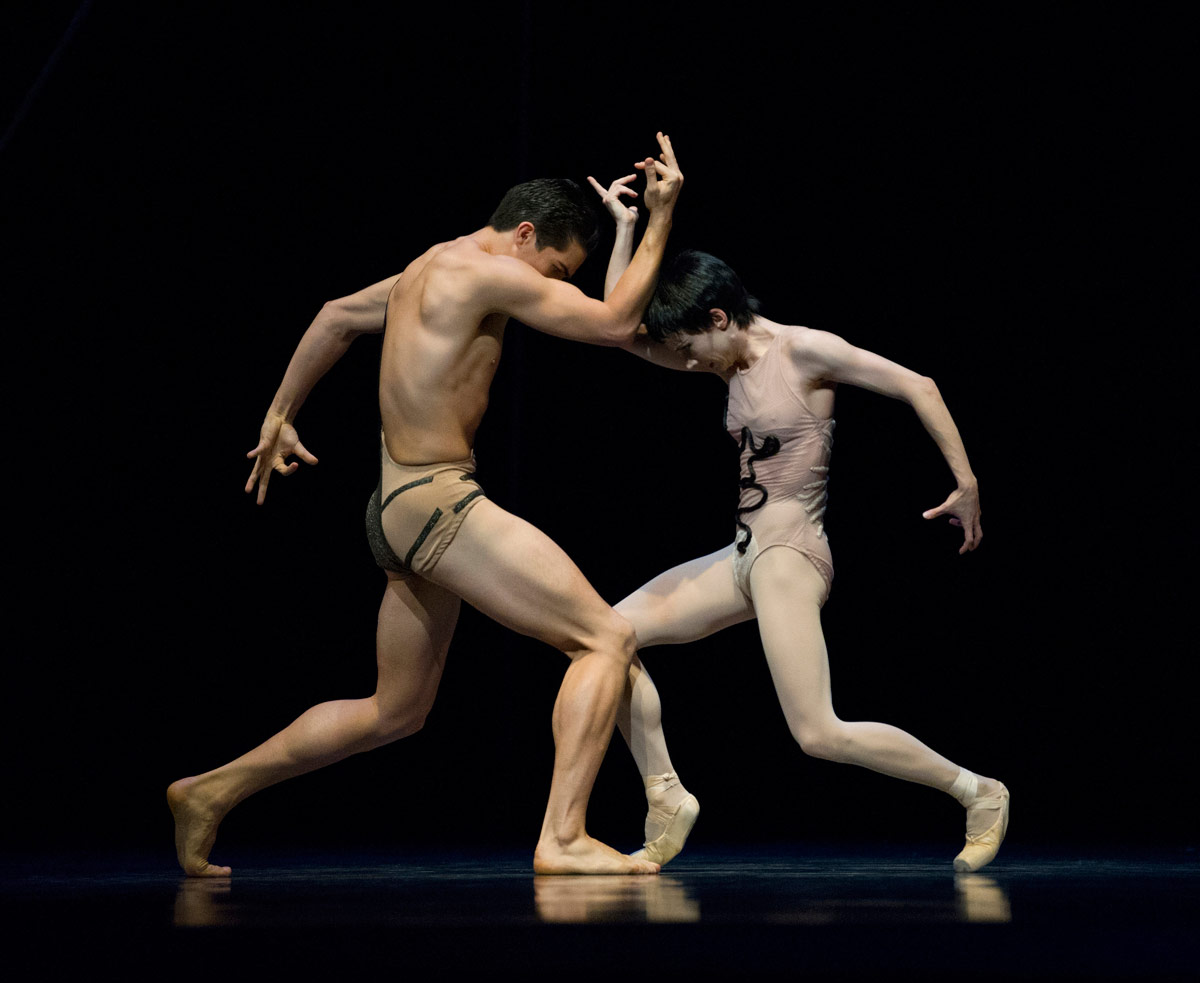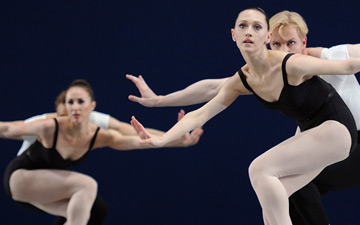
© Erik Tomasson. (Click image for larger version)
San Francisco Ballet
Robbins: Ballet & Broadway (Program 5): Opus 19/The Dreamer, The Cage, Other Dances, Fancy Free
★★★★✰
San Francisco, War Memorial Opera House
20 March 2018
www.sfballet.org
There’s nothing like watching a woman crush a man’s neck with her thighs to make you go hmm, maybe that whole #MeToo thing has legs. Just in case you were doubting that the power imbalance between men and women has needed addressing since long before 1951, when Jerome Robbins choreographed The Cage, in which not one but two men meet that erotically charged demise.
The Cage was one of four Robbins creations on San Francisco Ballet’s Program 5 bill, “Robbins: Ballet & Broadway,” which honors the master’s centenary and opened on Tuesday 20 March at War Memorial Opera House. Artistic director Helgi Tomasson credits Robbins with bringing him to America and serving as a mentor; spanning most of Robbins’s 50-year choreographic career, the bill ranged from his first-ever ballet, 1944’s Fancy Free, through 1976’s Other Dances to 1979’s Opus 19/The Dreamer, all of which explore male-female relationships in different and theatrical ways.
Set to Stravinsky’s dynamic 1946 Concerto in D for String Orchestra, “Basler,” The Cage shocked the midcentury mores of New York City Ballet audiences with its anti-ballet movement and unapologetic female aggression. The curtain opens on a hive of a female insect-creatures, whose Queen is initiating a newly-hatched Novice into the species’ eroto-cannibalistic ways. When two hapless males land in their midst, the Novice dispatches the one and then falls in love with the second, but ultimately does away with him pro forma. Love kills, indeed. Of course, this happens all the time in nature (see: Pennsylvania grass spider, day octopus), but in Homo erectus it seems to occur mostly in the imaginations of misogynistic men, of which Robbin’s was notoriously one.

© Erik Tomasson. (Click image for larger version)
The Cage is a fantastically theatrical and fun ballet, in which 14 women get to unleash their animus in wildly striped leotards and topknots of frizzed hair. Making their role debuts, Sofiane Sylve was magnificently merciless as the Queen (I’d hate to run into her in a dark web) while Maria Kochetkova, wearing a Zizi Jeanmaire pixie wig, unfurled wobbly limbs as a chrysalis Novice and quickly matured into a siren thirsty for the blood of Intruders Lonnie Weeks and Steven Morse. Around them, a tribe of twelve wild corps women stabbed the ground with their pointes to the music’s building rhythms.
Opus 19/The Dreamer and Other Dances struck a more reassuring romantic note. Opus 19 is a reverie set to Prokofiev’s Violin Concerto No. 1 in D major, Op. 19, in which a man in a white unitard (Carlo Di Lanno) swoons in the mode of a Romantic poet and conjures an enigmatic woman (Sarah Van Patten). The ballet is typically danced with softness on the male’s part and a harder edge on the woman’s; Di Lanno and Van Patten reversed those approaches on opening night, which muddied the timbre of the ballet. Still, Di Lanno’s gorgeously open épaulement and mile-long limbs created breathtaking extensions. And Robbins’s chorography, which hints at Balanchine’s Four Temperaments with its high kicks and wide-open arms for the corps (who danced beautifully), sets you on edge like a hypnopompic hallucination.

© Erik Tomasson. (Click image for larger version)
Like Dances at a Gathering and other of Robbins’s Chopin ballets, the nonnarrative Other Dances has its charms but is starting to look tired. Maybe it’s the diaphanous lilac-hued costumes or the tedious insouciance of the characters, or perhaps the ballets are too imbued with Robbins’s sentimentality about idealized, unattainable love. (Robbins was also notoriously cruel in personal and professional relationships.)
Robbins choreographed Other Dances for Mikhail Baryshnikov and Natalia Makarova, who danced it at a gala for New York’s Library of Performing Arts at Lincoln Center. Embellished with frissons of character dance, it’s custom-made for Russian dancers who train in mazurkas and polonaises since childhood, and who have a certain harsh clarity to their technique that contrasts with the softness of Chopin’s piano solos (played warmly by Natal’ya Feygina) and the loosely classical steps.
Principals Angelo Greco and Frances Chung (Italian and Canadian, respectively) debuted on opening night. Greco shares some qualities with Baryshnikov, including a stockier frame and impish charm, a big jump and musicality; he was well suited to the role. Chung has tremendous technical chops without the ice-hardened edge of a Russian-trained dancer, so her interpretation felt straightforward and lyrical, with too little mystery.

© Erik Tomasson. (Click image for larger version)
Fancy Free has #MeToo written all over it – three sailors playing keep-away with a lone woman’s purse, pressuring her to go to a bar with them, should tweak modern sensibilities far more than man-eating insectresses. At any rate, Robbins created the ballet, his first, for Ballet Theatre (now American Ballet Theatre) in 1944, with a score by the also not-yet-famous Leonard Bernstein. It was the height of World War II, and the 20-minute theater-ballet, which evolved into the Broadway musical and classic film On the Town, concerns three sailors on shore leave, looking for drinks and dames.
The entire cast made role debuts: soloist Esteban Hernandez and corps dancers Benjamin Freemantle and Lonnie Weeks as the sailors, with Freemantle as the sap who gets stuck paying the tab, and principals Dores André and Sasha De Sola as the women they coarsely woo and quickly lose.
Esteban attacked the first solo’s raucous jumps and turns, and Freemantle brought a goofy charm to the sap; neither yet possesses the technical or dramatic fireworks to fully realize the nuances that give these characters their definition. Weeks brought far more maturity to the third sailor, rhumba-ing and cha-cha-ing with wonderfully modulated phrasing, and the audience responded with laughter and cheers. André brought an almost stern authority to the first woman, and De Sola seemed genuinely infatuated with Freemantle. Corps member Maggie Weirich was an irresistible gamine as the gal who catches their eye in the end.
Overall, this was the strongest program of the season so far, drawing on the theatricality, wit and modernity that SFB does so well. Now that the company has paid homage to its heritage, it can look ahead: up next is the highly anticipated “Unbound: A Festival of New Work”s, where twelve world premieres will show how those qualities are manifest in ballet of the moment.
Martin West conducted the orchestra.

















Is this a review about San Francisco Ballet’s performance in 4 ballets choreographed by Jerome Robbins or a catalog of your personal feelings about him? If you wish to address Robbins’ appalling behaviour through out his professional life, then write an essay about it. Your wavering between review and commentary is not only incongurous, it reads as insincere and is a disservice to the hard working artists of SFB. Frankly, I am appalled that your editors allowed this to run.
Sorry you don’t like the review but it’s common in reviews to give some context or background that provides further illumination – be it in brief. As both a reader and editor I like that. I don’t think it does any disservice to the SFB dancers and artistic team and ultimately this is a 4 star review of the movement and the way it was danced. The start of the last para can leave no doubt: “Overall, this was the strongest program of the season so far, drawing on the theatricality, wit and modernity that SFB does so well.” It’s a great piece for me, but we will never please all the people all the time. BM, Ed.
Since I was privileged to see the original production at City Center in New York
City with Nora Kaye creating the role of the Novice and Yvonne Mounsey that
of the Queen, I have a memory of its responses at the time. As I recall, Robbins
created the role for Kaye, who had left Ballet Theatre, and either then, or shortly
thereafter, the two were briefly engaged.
The wig Claudia Baer describes reflects Nora Kaye’s haircut at the time and it
apparently has become de rigeur for subsequent interpreters. I remember Lucia
La Carra in the role in SF Ballet’s first production of the ballet, and her standard coiffure was anything but short.
Also, Robbins commented at the time that his ballet was simply an updating of the
Second Act of Giselle, prompting many of us to reflect on 19th century suggestions of female predators.